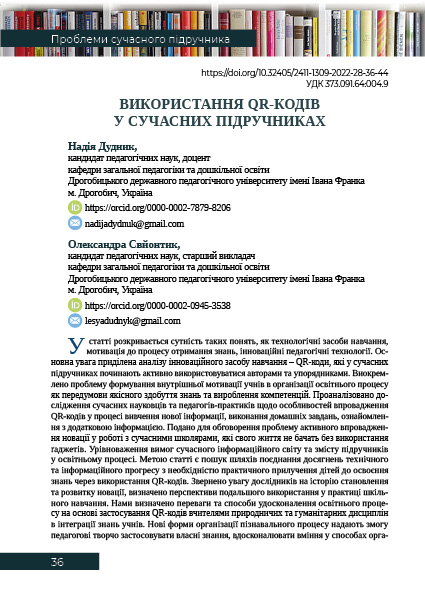
Published 2022-07-20
Keywords
- QR‑codes,
- innovative technologies,
- motivation to study,
- search activity,
- quality of educational process
- content of modern textbook ...More
How to Cite

This work is licensed under a Creative Commons Attribution-NonCommercial-ShareAlike 4.0 International License.
Abstract
The article reveals the essence of such concepts as technological teaching aids, motivation for the process of acquiring knowledge, innovative pedagogical technologies. The main attention is paid to the analysis of innovative teaching aids – QR‑codes, which in modern textbooks are beginning to be actively used by authors and compilers. The problem of the formation of internal motivation of pupils in the organization of educational process as preconditions of qualitative acquisition of knowledge and development of competencies is allocated. The research of modern scientists and teachers-practitioners on the peculiarities of the introduction of QR‑codes in the process of learning new information, homework, acquaintance with additional information is analyzed. The problem of the active introduction of innovation in work with modern schoolchildren who do not see their life without the use of gadgets is presented for discussion, balancing the requirements of the modern information world and the content of textbooks in the educational process. The aim of the article is to find ways to combine the achievements of technical and informational progress with the need for the practical involvement of children in the acquisition of knowledge through the use of QR‑codes. Researchers’ attention is drawn to the history of formation and development of innovation, the prospects for further use in the practice of schooling are determined. We have identified the benefits and ways to improve the educational process based on the use of QR‑codes by teachers of natural sciences and humanities in the integration of pupils’ knowledge. New forms of organization of the cognitive process allow the teacher to creatively apply his/her own knowledge, improve skills in the organization of learning. QR‑codes are defined as a progressive and variable component of information progress, accessibility in mastering a wide range of their use in the educational process. The perspective of pedagogical cooperation of teachers and students in the further use of alternative, author ‘s programs, which contribute to the improvement of the content of modern textbooks, is given.
Downloads
References
- Бугайчук, К. Л. (2012). Використання QR‑кодів у навчальному процесі вищих навчальних закладів. Інформаційні технології: наука, техніка, технологія, освіта, здоров’я (MicroCAD‑2012): матеріали ХХ міжнародної науковопрактичної конференції (15–17 травня 2012, м. Харків). Харків, 41–46.
- Гончаренко, С. (1997). Український педагогічний словник. Київ: Либідь.
- Гупан, Н. (2014). Відображення диференціації у методичному апараті шкільних підручників з суспільствознавчих предметів. Історія в школі, 4/5, 37–40.
- Іванова, Ю. (2016). Мотивація як чинник успішного формування навчально-пізнавальної діяльності учнів. URL: http://umo.edu.ua/images/content/nashi_vydanya/pislya_dyplom_osvina/1_2016/%D0%98%D0%92%D0%90%D0%9D%D0%9E%D0%92%D0%90.pdf.
- Ігнатенко, Н. (2021). Реалізація ідей проблемного навчання при вивченні історія у закладах середньої освіти. Історія в рідній школі, 1 (225), 21–24.
- Кононенко, О. В. (2015). Можливості використання QR‑кодів у навчальному процесі. URL: http://dspace.pnpu.edu.ua/bitstream/123456789/5170/1/Kononenko.pdf.
- Мар’яненко, Л. (2014). Рекомендації для педагогів щодо вміння формувати пізнавальний інтерес і пізнавальну потребу в молодших школярів. Практичний психолог: школа, 3, 40–48.
- Островський, В. (2004). Оцінювання навчальних досягнень учнів з історії: теорія і практика (на прикладі теми «Україна під час Другої світової війни») Історія в школах України, 9–10, 13–21.
- Ріжняк, Р., Туртуріка, В. (2020). Історія виникнення, застосування та перспективи розвитку технології QR‑кодування. URL: https://phm.cuspu.edu.ua/nauka/naukovo-populiarni-publikatsii/755-istoriya vynyknennya-zastosuvannya-ta-perspektyvy-rozvytku-tekhnolohiyi-qr-koduvannya.html.
- Сисоєва, С.О. (1996). Підготовка вчителя до формування творчої особистості учня: Монографія. Київ: Поліграфкнига.
- Сисоєва, С.О. (2001). Педагогічні технології і професійний розвиток особистості Prace Naukove. Ptdagogika, 8–9–10, 741–754.
- Терно, С. (2019). Гра цінностей та емоцій в освіті. Історія в рідній школі, 7–8, 45–49.
- Щупак, І. Я. (2019). Всесвітня Історія. Історія України (інтегрований курс): підруч. для 6 кл. закладів загальної середньої освіти. Київ: УОВЦ «Оріон».
- Що таке QR‑код та як його використовувати вчителю? (2018). URL: http://teach-hub.com/scho-take-qr-kod-ta-yak-joho-vykorystovuvaty-vchytelyu/.
- Charles, W. (2014). Hull received his European Inventor Award for the invention of 3D printing – a technology that is currently in use in numerous fields and that has triggered a veritable revolution in manufacturing. URL: https://www.epo.org/news-issues/news/2014/20140617.html
